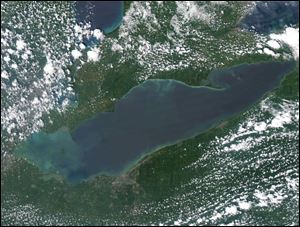
MICROCYSTIS ALGAE
Rest of region on high alert for contamination
8/3/2014
This satellite image shows the green algae currently on Lake Erie.
Toledo’s water emergency Saturday had a familiar ring for Henry Biggert, superintendent of the water treatment plant in Ottawa County’s Carroll Township, which was shut down for 12 days last September by a similar microcystin crisis.
“We definitely have our guard up,” Mr. Biggert said Saturday afternoon. “We’ve been working on this all year.”
But Carroll Township’s latest test sample, taken Wednesday, had shown none of the toxin, produced by the microcystis algae that have bloomed in recent weeks in western Lake Erie, in its raw water, much less the treated product it sends to its customers, Mr. Biggert said.
The city of Monroe’s water plant also was not affected, and leaders there said they test water samples on a weekly basis.
Officials from the nearby Ottawa County plant, which serves Oak Harbor and Port Clinton, said they had no microcystin in their water, either, but were on alert, while Oregon City Administrator Mike Beazley said the toxin had turned up in his city’s intake but so far had been successfully treated by increasing use of activated carbon.
“Every city with a water intake on Lake Erie has to be aware of the algae,” Mr. Beazley said, “and the steps to be taken to protect their drinking water.”
“It’s a train coming down the tracks, and we’re watching very closely,” said Kelly Frey, Ottawa County’s sanitary engineer.
Under a response plan it submitted earlier this year to state officials, Ottawa County is prepared to shut off the connections between its treatment plants and its water tower and towers belonging to Port Clinton and Oak Harbor if a microcystin problem develops there, Mr. Frey said. Those water towers provide more than 1 million gallons in water reserves that could be distributed for drinking and cooking in an emergency.
Mr. Biggert said he has a 500,000-gallon tank plus 640,000 gallons in underground storage that also could be isolated if need be.
With consumption of about 240,000 to 290,000 gallons per day, “we can kind of pick and choose when we draw” water from Lake Erie, Mr. Biggert said.
But last year, Carroll Township’s plant, which uses reverse osmosis to treat its water, was overwhelmed by the algal toxin. It took 44 hours for the township utility to tap into the Ottawa County supply, with customers dependent on bottled water in the interim, and 10 days after that for Carroll to resume its own plant’s operation.
How long it might take Toledo to flush out and restart its water system, Mr. Biggert said, will depend on how far into the system the toxin got and how the city clears it out.
Mr. Beazley said Oregon’s plant started detecting microcystin in its raw water about 11 days ago, but only intermittently at first, while levels Saturday were significantly elevated over Friday’s.
At no time has any microcystin been detected in Oregon’s treated water, he said.
Mr. Beazley said Oregon officials would not comment on why Oregon’s results were clean, and Toledo’s were not, even though their Lake Erie intakes are near each other.
Mr. Frey’s and Mr. Biggert’s plants both normally take samples to Oregon for testing each Wednesday. Mr. Frey said Ottawa County made an extra trip Saturday “because Toledo has problems,” but all results were negative, while Mr. Biggert said an extra trip is likely from Carroll’s plant today or Monday for the same reason.
Mr. Frey added that there will probably be “one great debate” Monday in Ottawa County about how often to test now that the algae has reached crisis level farther west on Lake Erie.
Fed largely by nutrients that flow into the lake from the Maumee River, he said, the algae blooms typically spread from west to east.
“We track it through satellite imagery” provided by the federal government, Mr. Frey said.
The sanitary engineer complained, however, that Lake Erie’s algae issue is being handled in a reactionary way, with little scientific examination of its causes, what its most effective treatments are, or even guidance of how often water-plant operators should be testing for microcystin contamination.
“We’re just throwing chemicals at it,” Mr. Frey said. “... As plant operators, we can only take the information that is given to us, and this is a new issue. The EPA has no guidance for us. The problem is way ahead of the science.”
Speaking outside the Lucas County Emergency Services Building in downtown Toledo, U.S. Sen. Rob Portman (R., Ohio) said reauthorization of a federal program to address harmful algal blooms and hypoxia research that he and Sen. Bill Nelson (D., Florida) co-sponsored — and which President Obama signed into law July 1 — should make inroads in that area.
“We do have a problem with these toxic algal blooms,” Mr. Portman said. The bipartisan legislation will provide funds for better research, remediation, and monitoring of algae, he said, noting that for the first time the program has language specifically prioritizing the Great Lakes.
U.S. Rep. Bob Latta (R., Bowling Green), said he plans to introduce legislation soon that would make the National Oceanographic and Aeronautical Administration a coordinating agency to gather information and research to disseminate to Congress, while U.S. Rep. Marcy Kaptur (D., Toledo), said the algae outbreak is further proof that steps are needed to curb fertilizer runoff into the Maumee River, which flows into Lake Erie.
“We need to stop loading nutrients into the lake. That’s the real solution,” Miss Kaptur said. The agricultural load on the Maumee, she said, accumulates in the water and lake sediment, and “that’s why [the blooms are] getting bigger and bigger.”
Contact David Patch at: dpatch@theblade.com or 419-724-6094.